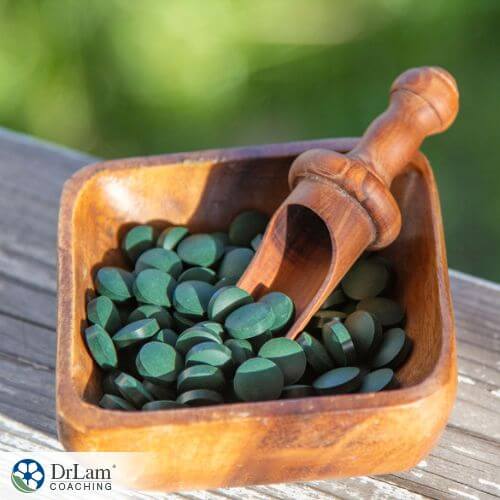 Not all supplements are all they are advertised to be. But are chlorophyll supplements one of these fads? Here's what you need to know before you buy one of these supplements.
Not all supplements are all they are advertised to be. But are chlorophyll supplements one of these fads? Here's what you need to know before you buy one of these supplements.
In a perfect world, nobody would need to take supplements. You would get all the daily vitamins, minerals, and nutrients you need from the food you eat. In real life, however, lifestyle choices, health conditions, and poor diet often result in deficiencies. And when that happens, we tend to opt for supplements like chlorophyll to make up the difference.
Any green plant or algae has chlorophyll. Plants use it, a green pigment, to absorb energy from sunlight and produce their own food through a process called photosynthesis. This process sees plants use stored energy to convert carbon dioxide into glucose. Together with nutrients taken up from the soil through the roots, this glucose is used to grow. A byproduct of photosynthesis is the release of oxygen into the air. Oxygen is essential to both human and animal life.
There are three types of chlorophyll supplements: liquid, powder, and pills. The liquid and powder can be added to a beverage like a glass of juice or a green smoothie.
Pill and powder supplements are often made from spirulina, chlorella, barley grass, and wheatgrass, amongst various others.
The liquid form is chlorophyllin. Chlorophyllin is not 100% natural. It is a semi-synthetic compound made of water-soluble sodium copper salts found in chlorophyll. It is often used as a food colorant and found in various cosmetics and drugs.
Chlorophyll has antioxidant properties. Antioxidants fight free radicals in your body. Free radicals are linked to numerous health conditions including diabetes, heart disease, and cancer. Back in the 1950s, when using chlorophyll supplements first became popular, people used it to address numerous health issues, such as:
Literature does suggest that chlorophyll, besides its antioxidant properties, also has anti-inflammatory properties. So many of those claims may have a point of truth attached.
However, most research into the benefits of chlorophyll has focused on its topical application where it may indeed prove beneficial to your skin health.
Unfortunately, not much research has been conducted to address the benefits of chlorophyll taken internally. And, it does have some side effects.
Chlorophyll may reduce your cancer risk or help address cancer and tumors. This is because it may promote cancer cell death in certain types of cancer like intestinal and pancreatic cancer.
A few small studies show that chlorophyll may promote weight loss. It may encourage feelings of fullness that may help reduce your appetite.
Your red blood cells contain hemoglobin. Hemoglobin has a similar chemical structure to chlorophyll. Because of this, it may help those with anemia, a hemoglobin deficiency, according to a 2016 study.
Chlorophyll may enhance the liver’s detoxification process by helping remove toxins and impurities. In so doing, it may also help prevent liver damage and liver cancer. Furthermore, it binds to heavy metals and improves blood circulation and oxygenation.
 Studies on the benefits of ingesting chlorophyll are rare, with research participants limited. We should thus regard the benefits mentioned as possibilities only. Other potential health benefits that still need study include:
Studies on the benefits of ingesting chlorophyll are rare, with research participants limited. We should thus regard the benefits mentioned as possibilities only. Other potential health benefits that still need study include:
Most of the research around the benefits of chlorophyll thus far has been on its topical applications.
Photobiomodulation refers to a process whereby non-ionized light in the visible and near-infrared spectrum help with healing at a molecular, cellular, and tissue level. Typical light sources include lasers, LED, and broadband light.
During a therapy session, the light source is placed either on or near the skin. The light energy, or photons, penetrates your tissue and interacts with chromophores in your cells. Photophysical and photochemical changes then occur.
The physiological changes that occur may help increase circulation, reduce inflammation and pain, accelerate wound healing, and help restore normal cellular processes. The process may improve inflammation, soft tissue pain, muscle health, muscle function, brain health, energy, and help with the removal of excess fat.
Chlorophyll enhances photobiomodulation activity at the mitochondrial level. This is done by increasing the adenosine triphosphate (ATP) levels in your mitochondria. ATP provides the energy needed for many different cellular processes. Different wavelengths are used in this process for different conditions.
Red light activated at 660 nm may benefit brain health in numerous ways. It may increase cell viability by decreasing oxidative stress. It may also increase brain-derived neurotrophic factor (BDNF) in your hippocampus.
BDNF is a neurotransmitter modulator that plays a key role in neuronal plasticity. This is important for certain brain functions like memory and learning. BDNF is also expressed in your gut and central nervous system and may have an indirect effect on liver health. For example, it controls glucose metabolism in your liver.
Chlorophyll has antioxidant properties. This means it fights free radicals that may cause cellular damage. Because of its ability to enhance healthy blood cell production and promote oxygenation, it also promotes the efficiency of various body processes, including detoxification. It also promotes liver health by means of its ability to control glucose metabolism. Your liver is one of the key components in your Detoxification Circuit.
In this way, chlorophyll may help reduce your body’s stress load. Stress is one of the major causes of health issues, including adrenal fatigue.
Your body’s automatic response to stress is the NeuroEndoMetabolic (NEM) stress response. Its aim is to protect immediate life while dealing with the stressor. After the stressor passes, the NEM returns to normal functions like repair and digestion. But when stress does not abate, the NEM stress response continues, resulting in various health issues related to inflammation and adrenal fatigue.
Stress may also encourage the buildup of toxins in your body. This is because, especially during the beginning phases of adrenal fatigue, you may see an increased output of stress hormones that may promote an inflammatory response. This also hampers your detoxification and other body processes.
As a result, your liver may encounter a buildup of reactive metabolites that could cause damage. Eventually, you may have a dysfunctional Detoxification Circuit which presents its own set of health challenges. Chlorophyll could help improve these detoxification issues.
 There are, thus far, no recommended dosages for chlorophyll supplements. You should thus abide by the recommendations provided by the chlorophyll supplement supplier.
There are, thus far, no recommended dosages for chlorophyll supplements. You should thus abide by the recommendations provided by the chlorophyll supplement supplier.
According to the Natural Medicines Comprehensive Database, supplement dosages of up to 300mg daily for three months appear to be safe.
If going for red light therapy, take your supplement about thirty minutes beforehand. This may improve your outcome with the therapy.
Firstly, no studies have been conducted on pregnant women, so you should not avoid a chlorophyll supplement if you are pregnant or nursing.
Another point of concern is that, like many other supplements, a chlorophyll supplement may interfere with certain prescription medications. For example, chlorophyll taken with medications that increase light sensitivity could increase your risk of sunburn and sun damage. This is especially true with liquid chlorophyll.
Most of the side effects of taking too much chlorophyll have thus far involved gastric issues. These include:
If you encounter any of these side effects, please stop using the supplement immediately and see your healthcare provider. If you eventually wish to continue using the supplement, do so at a much-reduced dosage.
Furthermore, keep in mind that the Food and Drug Administration does not regulate supplements. So make sure to read your labels and ensure the supplement has no additives.
Also, it is always best to consult your healthcare provider before starting to use any supplement. They are best able to determine whether it will work for you and the dosage.
The best way of ensuring your body gets the chlorophyll it needs is through your diet. Eating a variety of fresh fruit and vegetables will not only boost your chlorophyll levels, but also provide your body with the roughage, vitamins, minerals, and nutrients it needs to stay healthy. It will increase your antioxidant intake, soup up your immune system, discourage inflammation, and promote brain and organ health as well.
Foods that contain substantial amounts of chlorophyll include the following:
Consider using a variety of these fruits and vegetables in a smoothie. If using a powder or liquid chlorophyll supplement, consider adding it as well.
Chlorophyll, the pigment found in green plants, may have many potential health benefits, ranging from cancer prevention to liver health to promoting brain function. However, not much research has thus far been done on its benefit as a supplement. The best source of chlorophyll is plant foods. So stock up on your leafy greens and other beneficial, chlorophyll-rich produce.
If you would like to get more chlorophyll in your diet, here are a few things you can do about it.
If you would like to know more about chlorophyll and its uses and benefits, the team at Dr. Lam Coaching can help. We offer a free** no-obligation phone consultation at +1 (626) 571-1234 where we will privately discuss your concerns and assorted options. You can also send us a question through our Ask The Doctor system by clicking here.
In a roundabout way, chlorophyll does improve adrenal health. It has antioxidant properties, promotes detoxification, and reduces inflammation. Your healthcare provider can determine its suitability and dosage, taking your health history into account.
